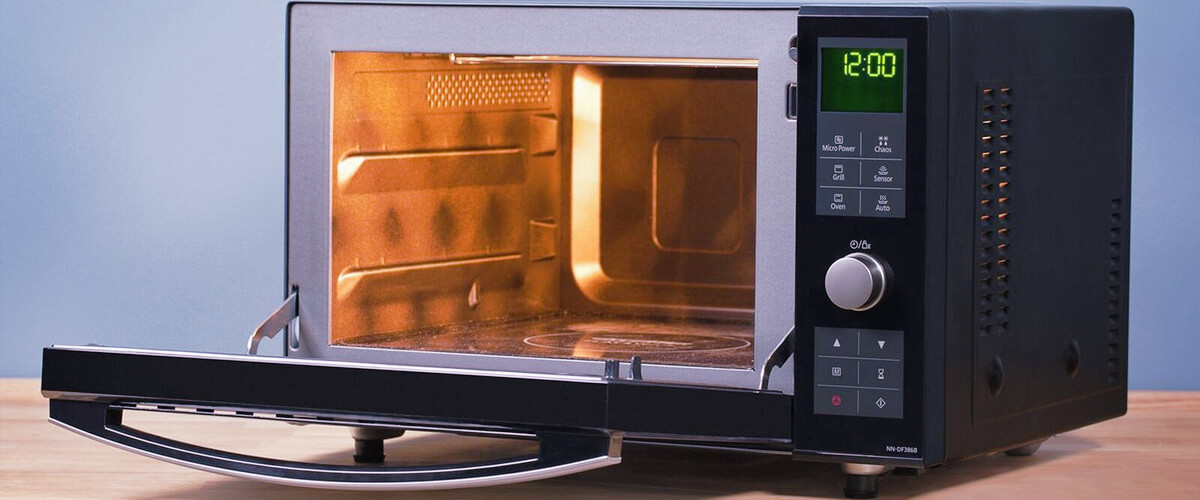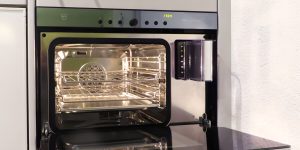In the realm of kitchen appliances, the speed oven and microwave have long reigned as go-to solutions for quick and convenient cooking. However, when it comes to selecting the ideal appliance for your culinary needs, understanding the differences between these two powerhouses is essential.
So, the topic of this article is speed oven vs microwave. I will compare and dissect the distinct features, capabilities, and performance of speed ovens and microwaves.
Functionality and technology

Speed ovens and microwaves are both kitchen appliances used for cooking but they operate differently. I want to share with you the functionality comparison of these devices.
A microwave works by generating electromagnetic waves, typically at a frequency of 2.45 gigahertz. These waves penetrate the food and cause the water molecules to vibrate rapidly, generating heat. This heat then cooks the food from the inside out.
On the other hand, high-speed ovens combine multiple technologies, including microwaves, convection, and sometimes even frying. These ovens use a combination of microwave energy, hot air circulation (convection), and in some cases, a heating element for frying to cook food. This combination allows for more versatile cooking options, including baking, roasting, grilling, and even frying.
Cooking times
Both of these appliances are designed to help you save time in the kitchen, but they work in different ways and have different strengths. So, let’s compare the cooking times of microwave vs. speed oven.
Actually, speed ovens are faster and more efficient than microwaves for cooking foods that require a crispy or browned exterior, such as pizza, roasted vegetables, and baked goods. This is because the hot air from the convection oven helps to distribute heat evenly and create a crispy exterior.
However, microwaves are typically faster and more efficient for cooking mostly liquid foods, such as soups, stews, and rice.
To illustrate the differences in cooking times, I’ve created a table comparing the cooking times for a few common foods in a speed oven versus a microwave.
| Food | Speed oven cooking time | Microwave cooking time |
|---|---|---|
| Baked Potato | 25 minutes | 8-12 minutes |
| Frozen Pizza | 18-20 minutes | 8-10 minutes |
| Broccoli | 8-10 minutes | 3-4 minutes |
| Rice | 25-30 minutes | 12-15 minutes |
Overall, both appliances have their strengths and weaknesses, and the best choice depends on the type of food you’re cooking and your specific needs in the kitchen.
Food quality

When we talk about the food quality that you can get when using these devices, you should take into account some differences between speed ovens versus microwaves. This difference is the reason for different effects on food’s texture, taste, and appearance.
The high-speed oven uses both convection heating and microwave technology, making it ideal for cooking a wide range of dishes. Regarding texture, the speed oven provides more even cooking and browning, resulting in a crispier exterior and a tender interior.
On the other hand, the microwave oven heats food by generating electromagnetic waves that cause water molecules in the food to vibrate and generate heat. This cooking method can result in heated food unevenly and lacking the desired texture and appearance. Therefore, microwaving is best for reheating leftovers and quick cooking rather than for cooking raw meat or baking.
Versatility
When comparing the cooking options, modes, and capabilities of a speed oven and a microwave, it becomes evident that the high-speed oven offers a broader range of features and functionalities. While both appliances are designed for quick cooking, reheating, and defrosting, the speed oven incorporates additional capabilities that are not typically found in standard microwave ovens.
My table below outlines the cooking options, modes, and capabilities of speed ovens and microwave ovens:
| Feature | Speed Oven | Microwave |
|---|---|---|
| Cooking options | Frying, baking, roasting, grilling, toasting, steaming | Reheating, defrosting, basic cooking |
| Cooking modes | Convection, microwave, combination | Microwave, grill, convection (in some advanced models) |
| Temperature control | Precise temperature control | Limited temperature control |
| Cooking speed | Rapid cooking times | Rapid reheating and defrosting, slower cooking |
| Versatility | Can handle a variety of dishes | Limited to certain types of food and reheating tasks |
| Size and design | Larger, built-in, or countertop versions are available | Compact, countertop models are common |
In conclusion, speed ovens provide an extended set of cooking options, modes, and capabilities compared to microwave ovens. The ability to fry, bake, roast, and perform various cooking techniques sets speed ovens apart, making them a preferred choice for individuals looking for a more versatile and advanced cooking appliance.
Energy efficiency

Speed ovens and microwaves have different power consumption levels and offer various energy-saving features. I have studied and tested the power consumption of these two types of equipment in practice and would like to share this information with you.
Microwaves typically consume less power than speed ovens, with power ratings ranging from 600 to 1,200 watts. They use microwave radiation to heat food quickly and efficiently.
On the other hand, speed ovens combine microwave and convection oven functions and have higher power ratings, typically ranging from 1,200 to 2,400 watts, due to the need for intense heat for convection cooking.
Both appliances incorporate energy-saving features. Programmable cooking allows users to set precise cooking times and power levels, avoiding unnecessary energy usage. Sensor technology is commonly found in modern microwaves and speed ovens, adjusting the cooking time and power output based on moisture or temperature levels in the food. Power settings in both appliances enable users to adjust the intensity of cooking, while standby modes reduce power consumption during idle periods.
While microwaves generally consume less power, the specific power consumption and energy-saving capabilities can vary depending on the model. Considering energy-efficient certifications and labels when making a purchase can help choose an appliance that aligns with energy-saving goals.
Maintenance and cleaning

Both speed ovens and microwaves are designed to be convenient and easy to clean and maintain, ensuring their longevity and optimal performance. I’ve prepared some information on their cleaning and maintenance processes along with tips to extend their life.
Speed ovens
Speed ovens often come with self-cleaning functions that help to remove grease and food residue. Regularly wiping down the interior with a damp cloth and mild detergent is recommended. Avoid using abrasive cleaners that could damage the oven’s surfaces. The oven’s accessories, such as racks and trays, can usually be removed and cleaned separately.
Microwaves
Cleaning a microwave is relatively simple. Start by wiping down the interior with a damp cloth or sponge and a mild dish soap solution. For stubborn stains or odors, you can place a bowl of water with a squeeze of lemon or vinegar inside the microwave and heat it for a few minutes to loosen the grime. Remember to wipe the exterior surfaces and control panel as well.
Maintenance tips for both appliances
My friend has both types of equipment that have been serving him for a very long time. This is all thanks to the proper care of equipment. He shared his secrets with me, and I will pass them on to you:
- Regularly check and clean the seals and gaskets to ensure they are free from debris or food particles. This helps maintain proper insulation and prevent energy loss.
- Avoid using metal utensils or containers that could cause sparks or damage to the appliance.
- Refer to the manufacturer’s instructions for any specific maintenance recommendations or procedures.
- Periodically inspect and clean the vents or filters to ensure proper airflow and prevent overheating.
- Avoid overloading the appliances, as this can strain the internal components and reduce their lifespan.
By following these cleaning and maintenance practices, you can keep your speed oven or microwave in good condition, extend its lifespan, and ensure efficient and safe operation.
Safety features

When comparing the safety features of a speed oven and a microwave, both appliances offer a range of built-in sensors and safety mechanisms to ensure user protection. Therefore, I’ve prepared this comparison to show you the principles of safety features of these devices:
Speed ovens often come equipped with sophisticated sensors that monitor internal temperature, humidity, and even food weight, allowing for precise cooking without the risk of overheating or burning. These sensors enable automatic shutdowns or adjustments to prevent accidents and maintain optimal cooking conditions.
Microwaves, on the other hand, have their safety measures. Most modern microwaves have built-in moisture sensors that detect steam levels and adjust cooking times accordingly, preventing food from becoming too dry or overcooked. Additionally, many microwaves feature automatic shutdown mechanisms that activate if the door is opened during operation, reducing the risk of accidental burns or exposure to harmful microwaves.
Both speed ovens and microwaves are designed with safety in mind, utilizing advanced technology and safety mechanisms to provide users with a secure cooking experience. However, it’s important to consult the user manuals and follow the manufacturer’s guidelines to ensure proper usage and maximize safety benefits.
FAQ
Can speed ovens replace conventional ovens in the kitchen?
Speed ovens offer the convenience of combining microwave technology with conventional oven functions, making them a versatile option. However, while they can handle various cooking tasks, including baking and roasting, they may not provide the same capacity and precise temperature control as dedicated conventional ovens.
How do I choose between a speed oven and a microwave based on my cooking needs?
When choosing between a speed oven and a microwave, consider the type of cooking you frequently do. For example, a microwave is a suitable choice if you value speed and convenience for tasks like reheating and defrosting. On the other hand, if you desire more cooking versatility, such as baking, grilling, or roasting, a speed oven would be a better fit.
Are there any health concerns associated with cooking food in a speed oven or microwave?
Both speed ovens and microwaves are generally safe for cooking food. However, following proper food safety practices and cooking instructions is important to ensure thorough and even heating. Some health concerns may arise from improper use of microwave-safe containers or heating certain types of food that may result in uneven heating. Therefore, it is always recommended to use microwave-safe cookware and follow manufacturer guidelines to ensure safe and healthy cooking.
Can speed ovens and microwaves be used for professional or commercial cooking purposes?
Speed ovens and microwaves are primarily designed for household use and may not withstand the demands of professional or commercial kitchens in terms of durability, capacity, and precise control. While they can be used for light professional cooking in certain settings, heavy-duty or high-volume cooking typically requires specialized commercial-grade equipment specifically designed for the rigors of professional kitchens.













